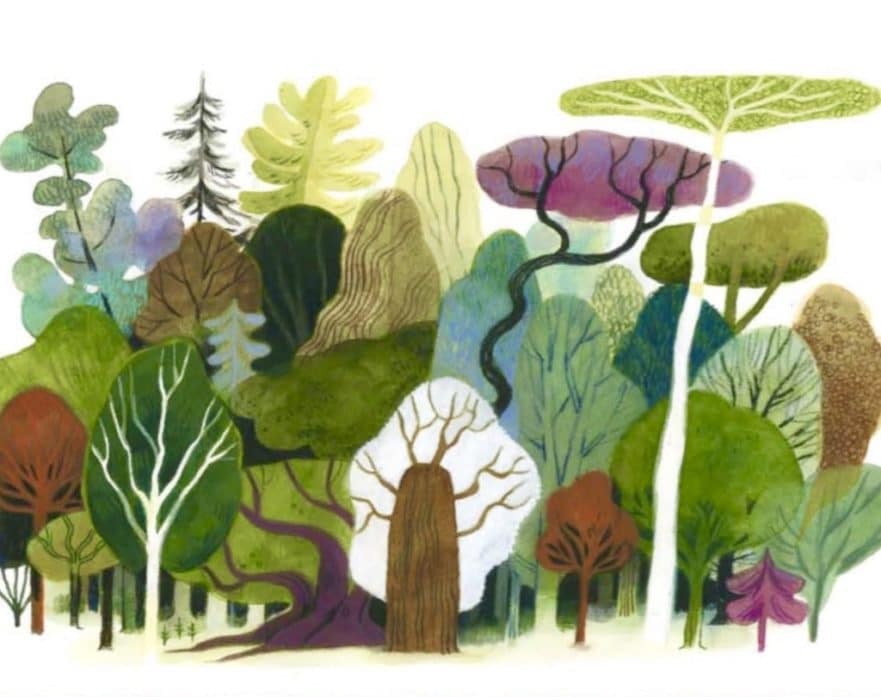We are all like trees: our spines, trunks and our skin, bark. Our hearts give us strength and support, like heartwood. We are fueled by air and sun.
Like humans, trees are social. They “talk” to spread information; they share food and resources. They shelter and take care of one another. They are stronger together.
***************************
“An encouraging nudge to look toward nature for guidance, and a valuable message that “together, we are a forest.”
The Horn Book Magazine
BE A TREE

Author – Maria Gianferrari
Illustrator – Felicita Sala
Stand tall.
Stretch your branches to the sun.
Be a tree!
These ten words begin Gianferrari’s lovely book celebrating the sheer beauty of one of nature’s gifts, and how humans have similar physical characteristics to this earthy treasure.

The bodies of trees and humans are not so different … our skin is like bark, protecting what’s within. Both species live in communities, sharing information. Trees signal each other through underground networks of roots and fungi … they “alert each other to danger.”

Both trees and humans live together in a community. Just as trees are linked underground through their roots, people are connected by sharing conversations, food, resources, and information.





The author continues to highlight all the benefits of trees, for they serve as animal habitats preserving ecosystems. The need for community is emphasized for trees that grow away from their natural habitat are at risk; therefore, a forest is vital for support. A beautiful double page fold out shows how people can learn from trees by helping one another.
In the final page spread, we are gently reminded to observe and learn from trees, for by banding together, we can not only be better as individuals but also make the world in which we live a better place.
**********************************************
SKETCH A TREE
On the cover of “Be A Tree” the illustration shows us the visible parts of the tree… the trunk and branches and the invisible parts of the tree…the roots and fungi. Like trees we have parts of us that others can see and parts they don’t always see. Let’s explore those parts of ourselves in this drawing.
LOOK FOR
-A brown paper shopping bag or a large piece of paper.
-Scissors
-Any art supplies you have (even a pencil or pen is enough).
SKETCH OUT A TREE
1. Cut out the large front or back panel of your bag. Leave the other 3 sides behind.
2. There should be a natural crease in the paper. Rotate the paper so that the smaller creased section is on the bottom of your paper.
3. Lay your arm above the crease and spread your fingers.
4. Reach for a marker, crayon or pencil and trace the outside of your arm and hand. Trace the v-shapes between your fingers. DON’T trace your fingertips.
Does this look like the outline of a trunk and branches?
5. Turn the paper around and place your wrist over the base of the “trunk.” Spread your fingers wide.
6. Trace the outside of your wrist and hand. Trace the v-shapes between your fingers. DON”T trace your fingertips.
Does this look like the roots of a tree?

WRITE & DRAW YOUR HIDDEN ROOTS…
1. Pull out your art supplies and look at the trunk and branches. What words of pictures could you add onto the trunk and branches that tell something about you? You could add things you are good at or things people think about you. Think about where you will write or draw on your tree. Words can become branches or leaves. Or words can run up the trunk like bark.
2. Now, look at the roots and soil beneath the ground. Add into the soil the things that help you grow strong. Yes, that could be food, and also think about what makes you a strong person.
Keep this piece of artwork to remind you to keep finding people and things that “feed you” or make you healthy and happy, growing taller and more beautiful under the blue sky.


